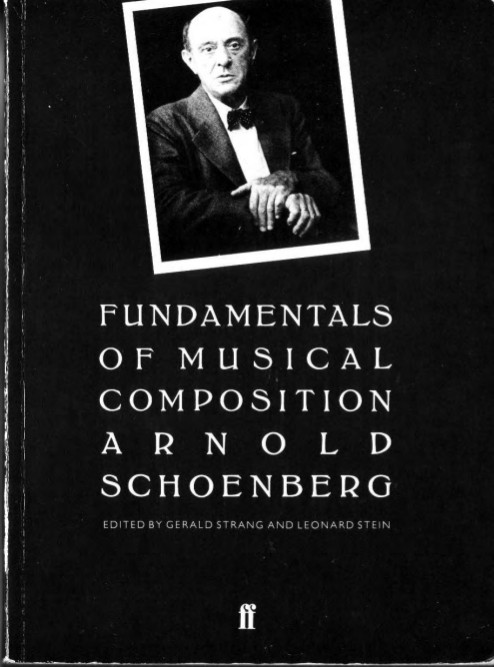Arnold Schoenberg: Fundamentals of Musical Composition (1967–) [EN, IT, ES, PT]
Filed under book | Tags: · composing, composition, music, music theory, sound recording

Fundamentals of Musical Composition represents the culmination of more than forty years in Schoenberg’s life devoted to the teaching of musical principles to students and composers in Europe and America. For his classes he developed a manner of presentation in which ‘every technical matter is discussed in a very fundamental way, so that at the same time it is both simple and thorough’. This book can be used for analysis as well as for composition. On the one hand, it has the practical objective of introducing students to the process of composing in a systematic way, from the smallest to the largest forms; on the other hand, the author analyses in thorough detail and with numerous illustrations those particular sections in the works of the masters which relate to the compositional problem under discussion.
Edited by Gerald Strang, with the collaboration of Leonard Stein
Introduction by Leonard Stein
Publisher Faber and Faber, London/Boston, 1967
ISBN 0571092764
256 pages
Fundamentals of Musical Composition (English, 1967, no OCR)
Elementi di composizione musicale (Italian, trans. Giacomo Manzoni, 1969, added on 2013-12-11)
Fundamentos de la composición musical (Spanish, trans. A. Santos, 1989, added on 2013-12-11)
Fundamentos da composição musical (Portuguese, trans. Eduardo Seincman, 1991/1996, added on 2013-12-11)
Sher Doruff: The Translocal Event and the Polyrhythmic Diagram (2006)
Filed under thesis | Tags: · aesthetics, art, collaboration, composition, digital art, emergence, media art, network art, performance, software, translocal performance
This thesis identifies and analyses the key creative protocols in translocal performance practice, and ends with suggestions for new forms of transversal live and mediated performance practice, informed by theory. It argues that ontologies of emergence in dynamic systems nourish contemporary practice in the digital arts. Feedback in self-organised, recursive systems and organisms elicit change, and change transforms. The arguments trace concepts from chaos and complexity theory to virtual multiplicity, relationality, intuition and individuation (in the work of Bergson, Deleuze, Guattari, Simondon, Massumi, and other process theorists). It then examines the intersection of methodologies in philosophy, science and art and the radical contingencies implicit in the technicity of real-time, collaborative composition. Simultaneous forces or tendencies such as perception/memory, content/expression and instinct/intellect produce composites (experience, meaning, and intuition- respectively) that affect the sensation of interplay. The translocal event is itself a diagram – an interstice between the forces of the local and the global, between the tendencies of the individual and the collective. The translocal is a point of reference for exploring the distribution of affect, parameters of control and emergent aesthetics. Translocal interplay, enabled by digital technologies and network protocols, is ontogenetic and autopoietic; diagrammatic and synaesthetic; intuitive and transductive. KeyWorx is a software application developed for real-time, distributed, multimodal media processing. As a technological tool created by artists, KeyWorx supports this intuitive type of creative experience: a real-time, translocal “jamming” that transduces the lived experience of a “biogram,” a synaesthetic hinge-dimension. The emerging aesthetics are processual – intuitive, diagrammatic and transversal.
Doctor of Philosophy, SMARTlab Programme in Performative New Media Arts, Central Saint Martins College of Art & Design, University of the Arts, London
288 pages
PDF
PDF (Appendix “The KeyWorx Interviews: Transcripts of Interviews and Conversations with KeyWorx Artists”)
Arnold Schoenberg: Theory of Harmony (1911–) [DE, IT, ES, EN, PT]
Filed under book | Tags: · composition, harmony, music, music theory, sound recording

“This book will come as a joy, a revelation, a warm reassurance. From this one book one might well learn less about harmony than about form, about aesthetics, even about life. Some will accuse Schoenberg of not concentrating on the topic at hand, but such an accusation, though well-founded, would miss the point of Theory of Harmony, because the heart and soul of the book is to be found in his vivid and penetrating digressions. They are the fascinating reflections of a great and humane musician who was a born writer as well.”
German edition
First published in 1911
Third edition, 1922
Publisher Universal Edition, Vienna
516 pages
English edition
Translated by Roy E. Carter, based on the third edition, published in 1922
Publisher University of California Press, 1983
ISBN 0520049446, 9780520049444
440 pages
Harmonielehre (German, 3rd Edition, 1922, added on 2013-12-11)
Manuale di armonia (Italian, trans. Giacomo Manzoni, 1963/1973, added on 2013-12-11)
Tratado de armonía (Spanish, trans. Ramon Barce, 1979, added on 2013-12-11)
Theory of Harmony (English, trans. Roy E. Carter, 1983, updated on 2012-8-3)
Harmonia (Portuguese, trans. Marden Maluf, 1999, added on 2013-12-11)

